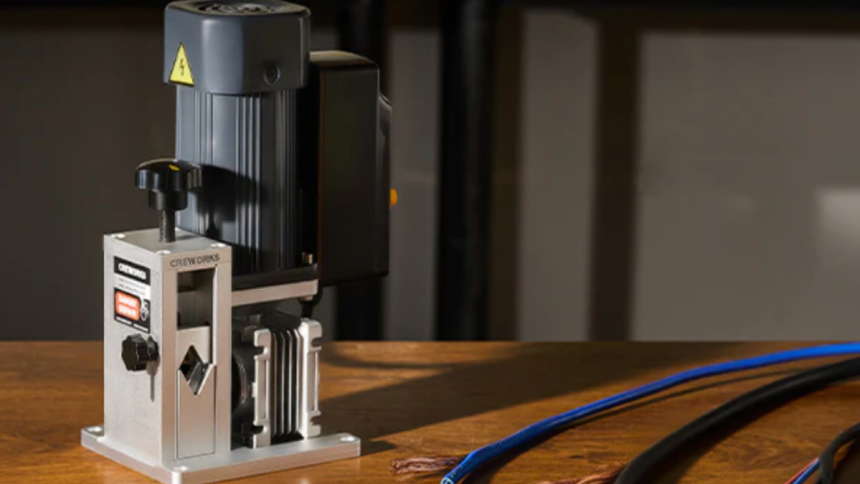Introduction
Wire stripping machines are essential tools for businesses and individuals working with scrap wire or other metal recycling processes. Properly maintaining these machines is crucial to ensure their longevity and continued efficiency. Without the right care, machines can suffer from excessive wear, leading to costly repairs or even total failure. By following a few simple maintenance practices, you can keep your wire stripping machine running smoothly for years to come. In this article, we’ll explore essential maintenance tips that will help extend the life of your machine, including how to keep it clean, lubricated, and properly adjusted.
1. Regular Cleaning is Key
One of the most straightforward ways to maintain your wire stripping machine is through regular cleaning. Dust, dirt, and metal shavings can accumulate on the machine’s components, causing them to become clogged and affecting the machine’s overall performance.
Cleaning Techniques:
- Use a soft cloth or a brush to wipe down the exterior of the machine. Pay particular attention to areas where dust can accumulate, such as vents, switches, and controls.
- Clean the cutting blades and feed rollers regularly to prevent buildup from affecting the quality of the wire stripping. A small vacuum or compressed air can be useful for clearing debris in hard-to-reach spots.
Frequency:
- It’s best to clean your wire stripping machine after each use, especially if you are stripping large amounts of wire. A general cleaning schedule can be maintained, but ensuring cleanliness after every major job will keep the machine running at peak performance.
2. Lubrication and Oil Maintenance
Lubrication plays a critical role in reducing friction and preventing wear on the machine’s moving parts. Over time, components such as the feed rollers, gears, and cutting blades can experience strain if not adequately lubricated.
Why It’s Important: Proper lubrication minimizes friction, ensuring smooth operation and preventing excessive wear on internal components. It also helps maintain the machine’s efficiency and reduces the risk of overheating.
Best Practices:
- Apply lubricant to the moving parts according to the manufacturer’s guidelines. Focus on areas such as gears, feed rollers, and any other points of friction.
- Use high-quality, non-abrasive oils or greases that are suitable for your specific model of wire stripping machine.
Frequency:
- Check the oil levels before each major use, and perform full lubrication on a monthly or quarterly basis, depending on your usage.
3. Blade Care and Replacement
The blades on your wire stripping machine are crucial for achieving clean, accurate cuts. Over time, blades can become dull, which can negatively impact the quality of the stripped wire and put extra strain on the motor.
Inspecting the Blades:
- Regularly inspect the blades for any visible signs of dullness, nicks, or wear. If the blades seem to be causing jagged cuts or are unable to strip wires effectively, they likely need attention.
Sharpening vs. Replacing:
- Blades can be sharpened to restore some functionality, but if they are significantly worn or damaged, it’s time for a replacement. Always refer to the machine’s manual for specific guidelines on blade maintenance.
Choosing Quality Blades:
- Whether sharpening or replacing, it’s important to choose high-quality blades that match the machine’s specifications. For example, Creworks wire stripping machines are known for their high-quality, durable blades designed for precision and efficiency.
4. Tension and Adjustment of Feed Rollers
Feed rollers help move the wire through the machine, and if they aren’t properly adjusted, they can cause uneven stripping or even damage to the wire.
Proper Alignment:
- Check the alignment of the feed rollers regularly to ensure they’re operating smoothly. Misalignment can lead to excessive tension, which might wear out parts prematurely or even cause jams.
Adjustments:
- Use the machine’s adjustment controls to ensure the rollers are properly spaced and that they provide the correct amount of tension. Be sure to follow the manufacturer’s instructions for roller adjustments to prevent over-tightening.
Routine Checks:
- It’s a good idea to check the feed rollers before every major use and periodically during operation. If you notice any issues with uneven stripping or wire jams, it’s likely due to misaligned rollers.
5. Monitor and Replace Worn Out Parts
Like any machine, your wire stripping machine will eventually show signs of wear on certain parts, such as belts, springs, and gears.
Common Parts to Check:
- Keep an eye on components such as the belts that drive the rollers, the springs that maintain tension, and any gears that control the machine’s movement.
When to Replace:
- Signs of wear include frayed belts, springs that no longer maintain tension, and gears that make unusual noises. Regularly inspect these parts and replace them as necessary to avoid more severe damage.
Sourcing Quality Parts:
- Always replace worn-out parts with high-quality, compatible components. For example, Creworks offers a variety of reliable parts designed for their stripping machines that ensure continued performance.
6. Environmental Considerations
Environmental factors like temperature and humidity can also affect the performance of your wire stripping machine.
Temperature and Humidity:
- Machines should not be exposed to extreme temperatures or excessive moisture. Too much humidity can cause rust and corrosion, while extreme heat can affect the electrical components.
Proper Storage:
- When not in use, store your wire stripping machine in a clean, dry area, ideally in a climate-controlled environment. This helps prevent damage from rust and ensures the machine remains in good working condition.
7. Periodic Professional Inspection
While regular cleaning and maintenance can keep your machine in good shape, periodic inspections from a professional technician are essential for detecting potential issues early.
Expert Maintenance:
- Technicians can perform more in-depth checks, such as examining the electrical system and motor to ensure they’re functioning properly. They can also identify minor issues that might not be visible to the average user.
Why It’s Beneficial:
- Regular professional maintenance can help spot problems before they become costly repairs. It can also extend the overall lifespan of your machine by keeping it in optimal condition.
8. Operating the Machine Correctly
How the machine is used is just as important as how it’s maintained. Incorrect operation can put undue stress on the machine and lead to faster wear and tear.
User Training:
- Ensure that all operators are properly trained on how to use the machine. Familiarity with the machine’s controls, features, and limitations can prevent mishandling.
Avoiding Overuse:
- Avoid running the machine for extended periods without breaks. Prolonged use can cause overheating and excessive strain on the motor and other components.
Following Manufacturer Guidelines:
- Always adhere to the manufacturer’s operating instructions to ensure that you’re using the machine in the most efficient and safe manner.
Conclusion
Maintaining your wire stripping machine is essential to ensure its continued performance and longevity. By following these tips — from cleaning and lubrication to regular checks of the feed rollers and blades — you can keep your machine running at its best. Investing in high-quality components and following proper operating procedures will also prevent unnecessary wear. Whether you’re using a model like the Creworks wire stripping machine or another top-rated machine, proper maintenance is the key to getting the most out of your equipment.
Lynn Martelli is an editor at Readability. She received her MFA in Creative Writing from Antioch University and has worked as an editor for over 10 years. Lynn has edited a wide variety of books, including fiction, non-fiction, memoirs, and more. In her free time, Lynn enjoys reading, writing, and spending time with her family and friends.














